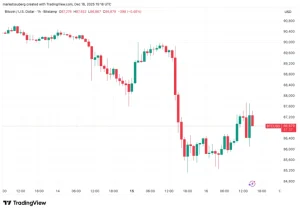Crypto Market Falters as Powell’s Remarks Trigger Bitcoin and Ethereum Decline

The cryptocurrency market witnessed a sharp correction this week, with Bitcoin and Ethereum leading the downturn after U.S. Federal Reserve Chair Jerome Powell signaled a more cautious stance on interest rate cuts. Powell’s remarks dampened investor optimism, prompting a sell-off across risk assets, including digital currencies. Bitcoin slipped below key psychological thresholds, while Ethereum and other major altcoins followed suit. The pullback reflects renewed concerns about liquidity, inflation persistence, and monetary tightening—factors that have historically influenced speculative asset classes such as cryptocurrencies.
Bitcoin Retreats as Monetary Outlook Shifts
Bitcoin, the world’s largest cryptocurrency by market capitalization, experienced a significant downturn following Powell’s comments during a policy discussion earlier this week. Prices fell sharply after the Fed Chair reiterated that inflation remains above target levels and that the central bank would maintain restrictive monetary conditions longer than anticipated.
Investors had entered the week with expectations of an early 2026 rate cut cycle, but Powell’s cautious tone quickly reversed market sentiment. Bitcoin, which had briefly climbed above Rs. 5,600,000 earlier this month, dropped to nearly Rs. 5,200,000, erasing a portion of its recent gains. The sudden move also triggered liquidations in leveraged trading positions, adding to volatility across major exchanges.
Market analysts suggest that Bitcoin’s reaction underscores its sensitivity to macroeconomic shifts. Despite narratives of being a hedge against inflation, the asset continues to behave in line with risk assets, responding negatively to tightening liquidity conditions.
Ethereum and Altcoins Follow the Slide
Ethereum mirrored Bitcoin’s decline, slipping below Rs. 310,000 amid broader market weakness. The world’s second-largest digital asset, which had rallied on optimism surrounding decentralized finance (DeFi) and exchange-traded fund (ETF) developments, faced renewed pressure as investor appetite for speculative assets waned.
Other prominent cryptocurrencies, including Solana, XRP, and Cardano, also saw price corrections ranging between 4% and 8%. Analysts attributed the broad-based pullback to a combination of macroeconomic caution and profit-taking by institutional investors who had entered positions during the summer rally.
Notably, liquidity in crypto markets has remained thin, amplifying price swings. Market makers report that even modest sell orders can trigger outsized moves due to the current lack of depth across spot and derivative exchanges.
Powell’s Comments: The Catalyst Behind the Decline
At the center of the market’s reaction were Powell’s statements highlighting the Federal Reserve’s commitment to a “data-dependent” approach to monetary policy. The Fed Chair reiterated that while inflation had moderated, it had not yet returned to the 2% target, warranting continued vigilance.
This stance effectively dashed expectations of imminent rate cuts, pushing U.S. Treasury yields higher and strengthening the dollar—both developments that typically pressure cryptocurrency valuations. The correlation between Bitcoin and high-growth technology equities has strengthened in recent months, making digital assets vulnerable to shifts in monetary policy sentiment.
Powell’s tone suggested that the central bank remains wary of prematurely easing policy, emphasizing that inflationary risks could re-emerge if financial conditions loosen too quickly. That message reverberated across global markets, leading to a sell-off in equities, commodities, and crypto alike.
Institutional Outlook: Short-Term Volatility, Long-Term Resilience
Despite the current correction, institutional strategists remain divided on the long-term outlook for Bitcoin and Ethereum. Some view the pullback as a healthy consolidation phase after an extended rally, while others caution that macroeconomic uncertainty could weigh on prices through the year’s end.
Investment firms tracking blockchain inflows noted that while short-term sentiment has weakened, long-term holding patterns among large Bitcoin wallets remain stable—a sign that core investors continue to view the asset as a hedge against future monetary debasement.
Ethereum’s fundamentals also appear resilient, supported by continued network upgrades and growing adoption of layer-2 scaling solutions. Analysts argue that while price action remains volatile, structural developments within the blockchain ecosystem could support long-term growth once macroeconomic headwinds ease.
The Broader Market Perspective
The crypto market’s retreat highlights an enduring theme: its vulnerability to traditional financial dynamics. Despite narratives of independence from central banking policies, digital assets remain tightly linked to global liquidity cycles. As long as interest rates remain elevated and risk sentiment fragile, cryptocurrencies are likely to face intermittent pressure.
However, analysts emphasize that each correction also serves to strengthen market maturity by flushing out speculative excess. With increasing institutional participation, regulatory clarity emerging in key markets, and blockchain technology advancing rapidly, the long-term trajectory of digital assets remains promising—albeit subject to periodic volatility.
Conclusion
Jerome Powell’s remarks once again demonstrated how central bank policy continues to exert powerful influence over the digital asset ecosystem. The crypto rally that had gathered momentum in recent months has cooled, reminding investors that monetary tightening and inflation dynamics remain decisive factors for market direction.
While short-term sentiment has turned cautious, the underlying momentum in blockchain innovation and institutional adoption offers a stabilizing foundation for future growth. For now, Bitcoin and Ethereum’s price correction underscores a familiar reality: in the era of global macro uncertainty, even the most decentralized assets remain tethered to the pulse of central bank policy.




